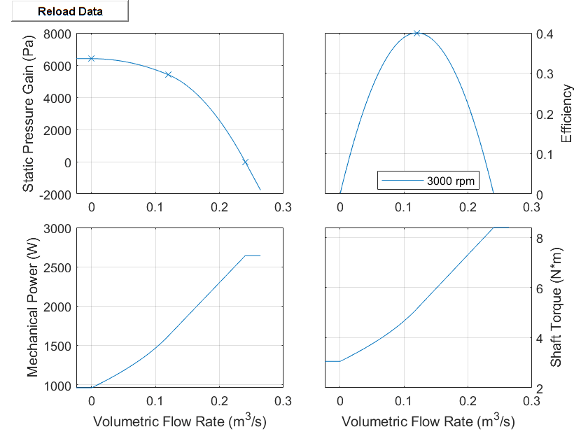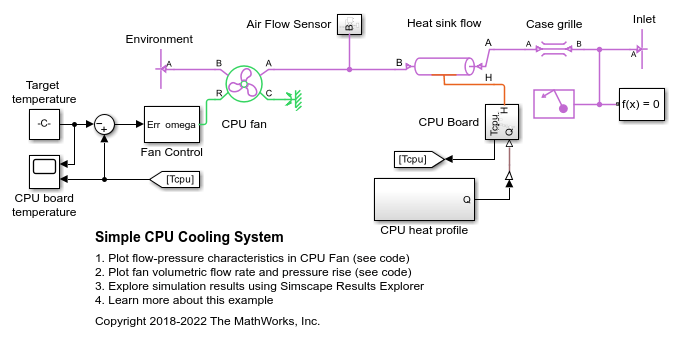Fan (G)
Fan in gas network
Libraries:
Simscape /
Fluids /
Gas /
Turbomachinery
Description
The Fan (G) block represents a fan in a gas network. You can model the torque and pressure gain over the fan as a function of static pressure and flow rate or by using 1D or 2D tabulated reference pressure, shaft speed, and flow rate data.
By default, flow and pressure gain are from port A to port B. Port C represents the fan casing, and port R represents the fan shaft. You can specify the normal operating shaft direction in the Mechanical orientation parameter. If the shaft begins to spin in the opposite direction, the pressure difference across the fan drops to zero.
Parameterization by Nominal Pressure, Flow Rate, and Shaft Speed
When you set the Fan parameterization parameter to Static
pressure and flow rate at reference shaft speed, the block uses
the analytical fan affinity laws and reference pressure differential to calculate
the pressure gain from port A to port B:
where:
Δpref is the reference pressure differential. The block uses a quadratic fit of the fan pressure differential values at the Maximum static pressure gain at zero flow, Nominal static pressure gain, and Maximum volumetric flow rate at zero pressure parameters.
ω is the shaft angular velocity, ωR – ωC.
ωref is the Reference shaft speed parameter.
is the Fan diameter scale factor parameter.
The block calculates the shaft torque from the reference mechanical power and the fan affinity laws:
Where Φref is the proportion of the pressure gain to the fan efficiency:
When you set the Shaft power specification parameter to
Fan efficiency, the block uses a quadratic fit of
efficiency between the fan peak performance,
ηnom, and 0.
ηnom is equivalent to the
Nominal efficiency parameter, which the block interprets as
the peak efficiency. If you set the Shaft power specification
parameter to Brake power, the block derives the nominal
fan efficiency from the nominal brake power,
Φnom, at peak or nominal conditions:
The block assumes the efficiency is zero when there is no flow or when the flow reaches the maximum volumetric flow rate at zero pressure. The block uses the current flow q to compute the reference flow rate as:
1-D Tabulated Data Parameterization: Pressure as a Function of Flow Rate at Reference Shaft Speed
When you set the Fan parameterization parameter to 1D
tabulated data - static pressure vs. flow rate at reference shaft
speed, you can model fan performance as a function of volumetric
flow rate. The block interpolates the pressure gain from port A
to port B from the 1-D Static pressure gain
vector parameter,
Δpref(qref):
Here, ρ is the moist air density, and ρref is the reference density, which is equivalent to the Reference density parameter. The block calculates the shaft torque from the reference mechanical power and the fan affinity laws:
where ρref is the Reference density.
The block uses the current flow q to compute the reference flow rate:
When the simulation is outside the range of the provided tables, the block extrapolates pressure based on the average slope of the fan curves and the reference torque to the nearest point.
2-D Tabulated Data Parameterization: Pressure as a Function of Shaft Speed and Flow Rate
When you set the Fan parameterization parameter to 2D
tabulated data - static pressure vs. shaft speed and flow rate,
you can model fan performance as a 2-D function of volumetric flow rate and angular
velocity. The block interpolates the pressure gain from port A
to port B from the 2-D Static pressure gain table,
dp(w,q) parameter. The block defines the reference pressure gain,
Δpref(qref,ω), as
The block calculates shaft torque from the reference mechanical power and the fan affinity laws:
where the reference mechanical power is a function of the reference flow rate and the current shaft speed.
The block uses the current flow q to compute the reference flow rate:
When the simulation is outside the range of the provided tables, the block extrapolates pressure based on the average slope of the fan curves and the reference torque to the nearest point.
If your table has unknown data points, use NaN in place of these
values. The block fills in the NaN elements by extrapolating
based on the average slope of the fan curves. Do not use artificial numerical
values because these values distort fan behavior when operating in that region.
When using unknown data:
The
NaNelements in the table must be contiguous.The positions of the
NaNelements in the Static pressure gain table, dp(w,q), Efficiency table, eta(w,q), and Mechanical power table, W(w,q) parameters must match each other.NaNelements must be located in the upper-right portion of the table, which corresponds to the highest volumetric flow rate and lowest shaft speed.
2-D Tabulated Data Parameterization: Flow Rate as a Function of Shaft Speed and Pressure
When you set the Fan parameterization parameter to 2D
tabulated data - flow rate vs. shaft speed and static pressure,
you can model the flow rate through the fan as a 2-D function of pressure and
angular velocity. The volumetric flow rate is interpolated from the 2-D
Volumetric flow rate table, q(w,dp) parameter,
qref. The reference flow rate is a
function of the reference pressure gain,
Δpref, and the current shaft speed,
ω:
where the reference pressure gain derives from the pressure differential over the fan:
The shaft torque derives from the reference mechanical power and the fan affinity laws:
where the reference mechanical power is a function of the reference flow rate and the current shaft speed.
When the simulation is outside the range of the provided tables, the block extrapolates pressure based on the average slope of the fan curves and the reference torque to the nearest point.
If your table has unknown data points, use NaN in place of these
values. The block fills in the NaN elements by extrapolating
based on the average slope of the fan curves. Do not use artificial numerical
values because these values distort fan behavior when operating in that region.
When using unknown data:
The
NaNelements in the table must be contiguous.The positions of the
NaNelements in the Volumetric flow rate table, q(w,dp), Efficiency table, eta(w,dp), and Mechanical power table, W(w,dp) parameters must match each other.NaNelements must be located in the upper-right portion of the table, which corresponds to the highest volumetric flow rate and lowest shaft speed.
Power and Efficiency
You can specify shaft power as either fan efficiency or brake power.
The block calculates efficiency as
where the brake power, or mechanical power measured at the shaft, is
The block calculates fluid power as
The block calculates torque as
Visualizing the Fan Curve
You can check the parameterized fan performance by plotting the pressure, power, efficiency, and torque as a function of the flow. To generate a plot of the current fan settings, right-click on the block and select Fluids > Plot Fan Characteristics. If you change settings or data, click Apply on the block parameters and click Reload Data on the fan curve figure.
The default block parameterization results in these plots:

Assumptions and Limitations
If the shaft rotates opposite to the specified mechanical orientation, pressure difference across the block drops to zero and the results may not be accurate.
The block assumes that the fan is quasi-steady.
The block simulates fan performance in terms of static pressure rise, and not total fan pressure.
Examples
Ports
Conserving
Parameters
Extended Capabilities
Version History
Introduced in R2018bSee Also
1 Prior to R2021b, this setting was called 2D tabulated data -
flow rate and total efficiency vs. angular speed and static
pressure.

